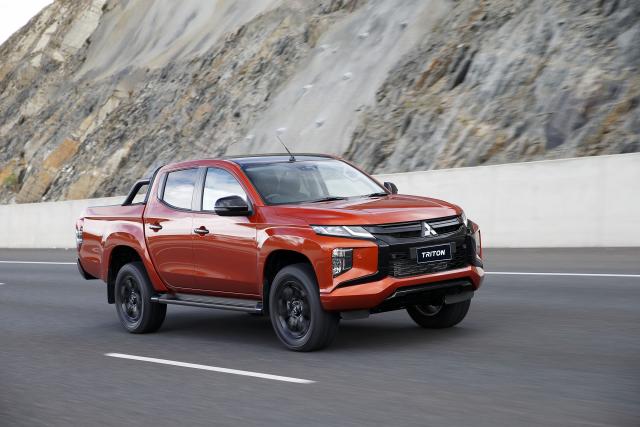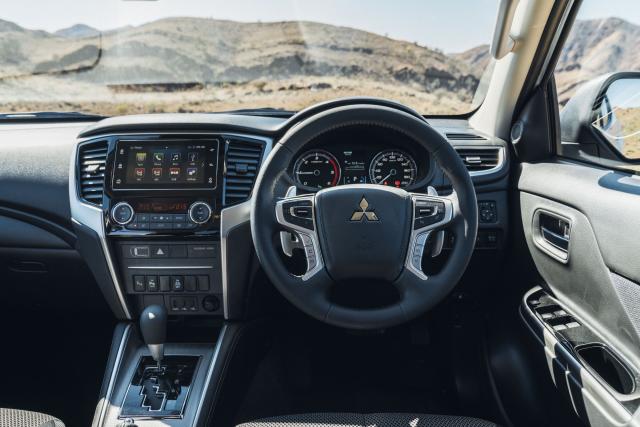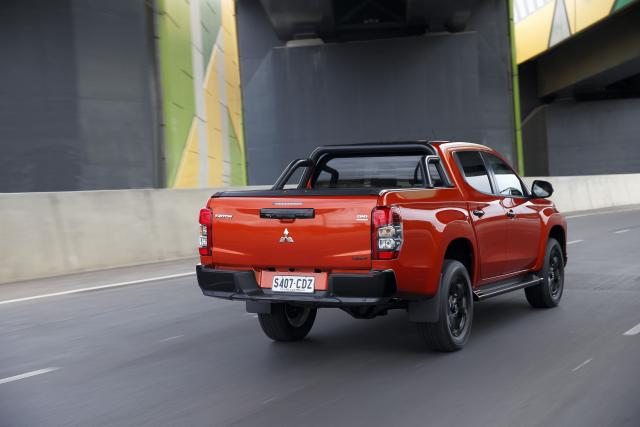
The Triton tapped danced up and down the concrete ‘boards’ of the motorway, leaving occupants shakin’ all over. Thankfully, this was no polka: ‘three-sixties’ here would have been well out of order.
On minor-road bitumen the terpsichorean bobbing up and down stepped aside for the GSR dual cab ute to settle for the odd bounce when encountering surface blemishes. Let’s face it, most utes exhibit some degree of rodeo riding. However, there is work to be done here.
The new Triton is a relative late comer to the dual cab ute segment dominated by the Toyota HiLux and Ford Ranger, the Mitsubishi relying on value for money in its appeal. Unfortunately, this has resulted in Triton being seriously challenged by the likes of the Mazda BT-50 and Isuzu D-Max, not to mention Chinese and Korean offerings.
Mitsubishi Australia offers the MY22 Triton in six variants, with the GLX from a bargain basement $44,240 drive away. The range is rounded out by the GSR from $65,740 drive away. The latter was on test.
Accessories across the range are designed to suit most needs. Select from a Work Pack, Tradie Essential Pack, Starter Pack, Polished Pack or Black Pack.
Out in front with its 10-year 200,000-kilometre Diamond Advantage warranty, the maker offers Triton cover, provided all scheduled servicing is done on time and by an authorised Mitsubishi dealer.
STYLING
The all-over black GSR test vehicle sported 18-inch alloy wheels and blacked-out grille. clamshell-style doors, platform side steps and grab handles made for easy access.
Efficient LED headlamps and daytime running lights are in line with the latest look in pick-up truck design.
On the smaller side of the segment, the ‘tucked in’ Triton’s less than 12 metre turning circle does make for easier parking than many of its segment rivals.
INTERIOR
The cabin décor certainly makes a statement with orange leather appointed seats, black leather door trims with orange stitching, the latter repeated on the steering wheel, gear shift knob and park brake lever.
The luxe look is let down somewhat by black plastic surrounds, which are present in abundance.
Front seats are heated, while two rear seat passengers are well catered for with generous leg room and a reclined seatback angle allowing ample, head and shoulder room – three across not so.
The bench seat back folds to expose a slim storage space across the width of the cabin. Storage, in general, is well covered with cup holders all round, a cubby up front, deep centre console and big-bottle door slots.
Out back, the tub dimensions – 1520 mm long, 1470 mm wide, 475 mm deep – are some of the smallest in the segment, while four integrated cargo hooks can safely secure a variety of loads.
INFOTAINMENT
In these days of tablet-style technology, a small(ish) touchscreen, covering Apple CarPlay, Android Auto and DAB+ digital radio, dwells in the past, while a head-up display on the windscreen, covering speed and legal speed limits, catches up with present-day standards.
Analogue instruments literally dial up memories of the old workhorse, the layout relating to modern times only by a digital display between the two gauges.
ENGINES / TRANSMISSIONS
The MY22 Triton relies on the tried and tested (ageing) 2.4-litre Mitsubishi MIVEC common-rail, intercooled turbodiesel engine putting out 133 kW of power at 3500 rpm and 430 Nm of torque at 2500 revs.
A six-speed automatic transmission and Super Select II 4×4 system cover the spectrum of on- and off-road capability.
SAFETY
The five-star ANCAP safety grade won in 2015 would not be up to today’s five-star standards.
However, Mitsubishi Intuitive Technology (MITEC) does incorporate such technical advantages as antilock braking with electronic brakeforce distribution; forward collision mitigation; ultrasonic misacceleration mitigation; blind spot and lane departure warning; lane change assist; hill descent control; all-round monitor; hill start assist; reverse parking camera and sensors; and rear cross-traffic alert.
Passive safety is covered by seven airbags and an audible warning to pedestrians when the vehicle is reversing.
DRIVING
Constructed in lightweight materials, including an aluminium block, it’s fuel efficiency over performance with the Triton 2.4-litre turbodiesel powerplant. Ponderous off the mark but relaxed and co-operative at cruising speeds.
Note: leave the steering wheel-mounted metal shift paddles alone. They add little to the driving experience. It’s definitely a case of engine management knows best.
Mitsubishi puts fuel consumption in the combined urban / highway cycle at 8.6 litres per 100 kilometres. On test the GSR recorded 11 litres per 100 kilometres city commuting and 6.7 litres per 100 kilometres on the open road.
As mentioned above, a rigid ladder chassis; up front, double wishbones with coil springs and stabiliser bar; and above-axle leaf spring rear suspension had their moments.
Super Select II 4×4 system incorporates four modes – 2H, rear-wheel drive; 4H, full-time power to all wheels; 4HLC, 4WD high range with locked centre differential, minimises wheel spin with low grip; 4LCC, 4WD low range with locked centre diff, maximum traction at low speed. The switch between two and four-wheel drive can be made safely on the fly at speeds up to 100 km/h.
Tow rating is 3100 kg braked and 750 kg unbraked. The test vehicle tonneau cover provided a test of strength to clip it down until it finally surrendered to perseverance. The high-set lined tub (aren’t they all, these days) also offered up a few loading challenges during the test.
Rear seat occupants commented on the efficiency of the climate control back there with its dual air vents in the roof.
SUMMARY
While lacking in some of the niceties of the modern pick-up truck work-and-play combination, the Triton GSR does not carry the load of premium pricing of some of its opposition.








